Iranian Death Row Prisoner’s Children Plead For Help

The children of Abbas Deris, a death row prisoner, demanded his release and global action to prevent the execution of their father.

The children of Abbas Deris, a death row prisoner, demanded his release and global action to prevent the execution of their father.
Deris, 49, and his 29-year-old brother Mohsen, were arrested during the Mahshahr canebrake crackdown in 2019; one of the bloodiest suppressions in the Islamic Republic, ignited by the sudden sharp increase in fuel prices in the country. It soon turned into an anti-government movement.
The brothers' initial charges included moharebeh (enmity against God), disrupting public order, and murdering a special unit officer. In October 2022, Mohsen was sentenced to death for the moharebeh charges, while his brother was acquitted.
Iran's supreme court upheld the death sentence issued to Deris last week.
"Our mother suffered a stroke and died after learning the death sentence for our father. We have no one except our father," stated his three children in a video published on social media.
Fereshteh Tabanian, his lawyer, tweeted last week that the Supreme Court had upheld Deris' death sentence without taking into account the objections she had filed on July 5.
According to Tabanian, Deris has denied involvement in the shooting, while the family of the deceased special forces officer has consented to a pardon.
The unarmed protesters in northern Mahshahr were shot dead by security forces after blocking the street. Security forces fired heavy artillery and set parts of the canebrake on fire when protesters ran towards it to take cover. Eyewitnesses said there were at least 20 deaths on the street and 40 deaths in the canebrake.
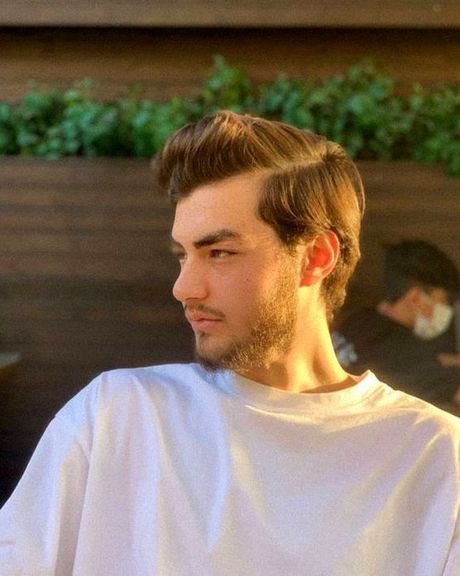
The father of one of the victims of Iran's recent protests was tried on charges of "assembly and collusion with the intention of disrupting national security".
Ali Rouhi's court session was held Tuesday at Branch 26 of Tehran Revolutionary Court.
He is the father of Hamidreza Rouhi, a university student who was shot dead near his home in Shahr-e Ziba neighborhood in the west of the capital on November 18.
Ali Rouhi was arrested on April 6 after he invited people to attend the birthday of his murdered son. He was released from Evin prison on bail on April 9.
Rouhi's family has been under pressure for attempts to keep their son’s memory alive.
Following the "Woman, Life, Freedom" movement, the families of many of the victims did not remain silent and began to reveal the brutalities of the regime.
However, security and intelligence organs try to silence them by threats, intimidation, and arrests.
Zahra, the sister of Milad Saeedianjou, is one of the petitioners who was arrested for the second time on July 10.
In the past months, the family members of a number of those killed in protests, including Abolfazl Adinehzadeh, Javad Heydari, Reza Lotfi, Hamed Selahshour, Artin Rahmani, Navid Afkari, Pouya Bakhtiari, Farzad Ansarifar, etc., were arrested and charged with political crimes.
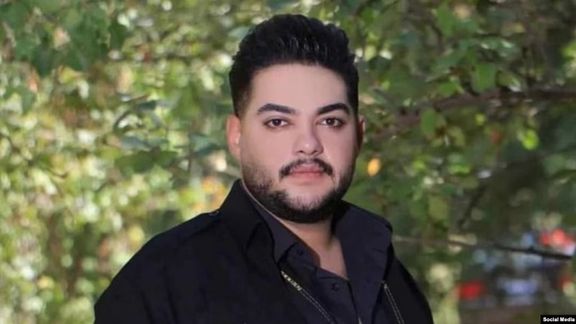
Several photos have been released proving that Iranian Kurdish political prisoner Peyman Galvani was tortured to death in detention.
Galvani, 24, whose death was announced July 9 was a resident of Mahabad in western Iran and was admitted to Khomeini Hospital after falling into a coma, according to Hengaw Human Rights.
On Tuesday, Radio Farda released the photos of his bruised and battered body that indicated the severity of his injuries.
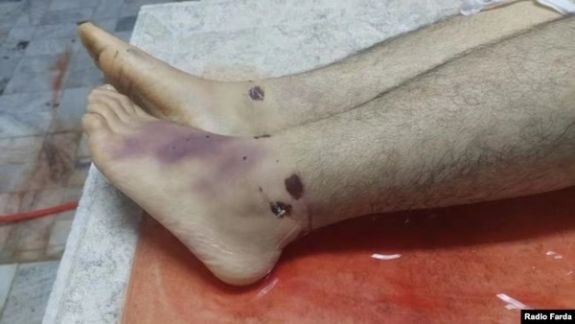
His family was informed that Galwani had "fallen from a height" leading to his comatose state.
According Hengaw, he died about two weeks after he was violently arrested by the security forces at his family home in Mahabad on June 25.
In the hospital, two security officers kept watch over him and prohibited family visits other than one exception made for his sister who observed extensive bruises on his body, head, and face.
His family says his death was the result of torture inflicted by the security forces, since the otherwise healthy young man did not have any preexisting medical conditions.
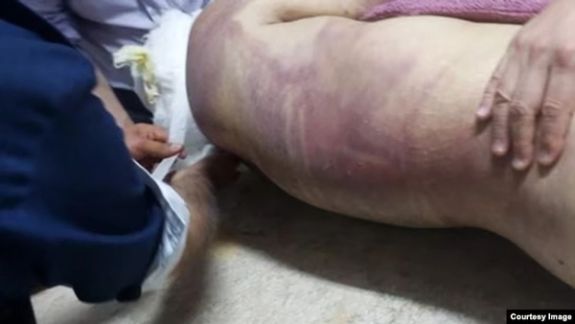
He is the second political prisoner who succumbed to his injuries in less than 24 hours as the regime continues its brutal suppression of opponents.
Kurdish human rights organizations reported Sunday that Mousa Esmaili, a political prisoner from Piranshahr in Iran’s West Azarbaijan province was also tortured to death.
Iranian intelligence and security agencies often bring unsubstantiated charges against dissidents, who are then tried behind closed doors without a lawyer. Several have died in unclear circumstances and torture.
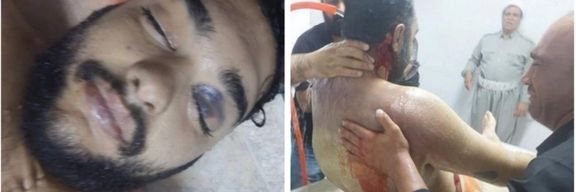
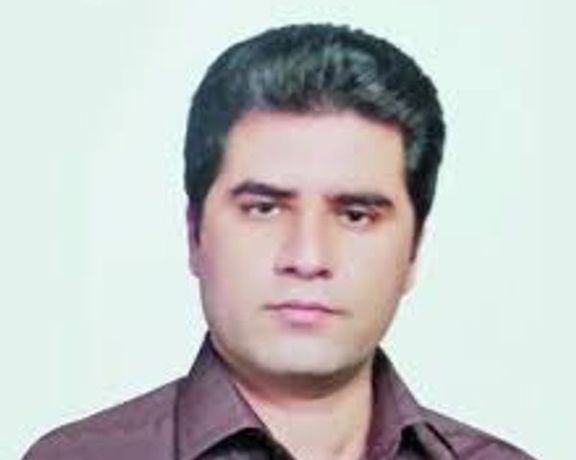
The family of Iman Valadbeigi, a 42-year-old protester who disappeared after the Iran-US football match in the World Cup 2022, told Iran International they have no information about his condition or whereabouts.
Mojtaba Valadbeigi, father of Iman, who is a war veteran, said "My son was born on May 1, 1981 in Isfahan, but he lives in Tehran. He is a mechanical engineer and took part in protests. Even at home, he explained to us how to participate in the demonstrations and told us the details of what happened on the streets."
"Iman went out after the football match between Iran and the United States but did not take his cell phone. Since then, we have no information about him."
He further noted that he has been looking for his son for 223 days, but to no avail.
"The staff of the prosecutor's office told me that there are many examples like Iman and the number of missing people from the events of the 2022 fall is high," the father added.
Iman Valadbeigi is not the only missing person during the anti-regime protests following the death in custody of Mahsa Amini, as there are other citizens who disappeared then.
Reza Abbasi, a 21-year-old resident of Robat Karim region of Tehran, is one of the other citizens who went missing since November 12.
His mother also said that they searched "all the hospitals, forensic centers and prisons" but did not find any trace of him.
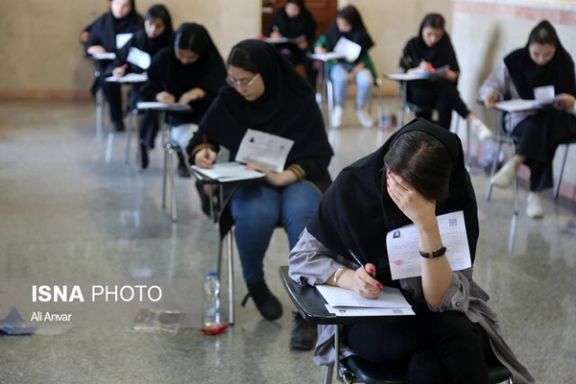
Students from the wealthiest families have a much greater chance of admission to top universities in Iran, as many blame corruption by the entrance exam ‘mafia’.
In a program aired by the state television Sunday, Mansour Kabkanian, a member of the Supreme Council of the Cultural Revolution, said 48 percent of the hugely sought after 3,000 seats, such as those in medical and engineering schools, are taken by students hailing from the top income percentile families while students from the bottom income brackets only manage to make it to 0.2 percent of top majors.
Only 1.3 of applicants from the bottom three percentiles make it to medical and dentistry schools against 86 percent from the top three, he said, adding that in some engineering fields, such as electrical engineering at Sharif University of Technology, the three bottom percentiles have no chance at all but those from the top three percentiles make up 87 percent of all students admitted.
Many Iranians believe that the standardized university entrance exams, known as Concours, which is usually held at a nationwide scale in summer every year, is responsible for such a huge gap in admission of students from the wealthy and underprivileged families.
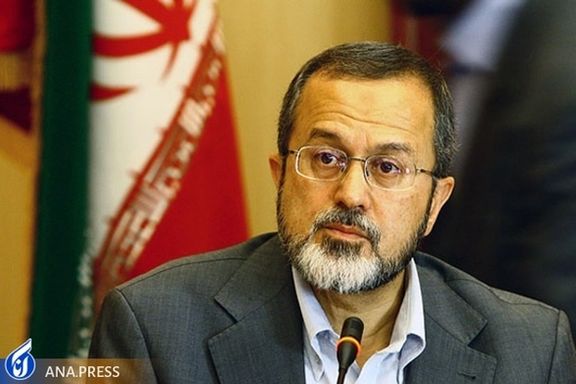
They argue that Concours only allows for those with money who can afford not only top private schools, but also preparatory classes and private lessons, expert advice on making the best choices, and even corrupt practices such as purchasing the test questions and their correct answers at astronomical prices.
Those profiting from the lucrative business of running Concours classes and publication of expensive study material have for years used their influence and money to prevent the entrance exam system being replaced by better and fairer methods of student admission to universities, the media have been saying for years.
The Iranian media have dubbed the allegedly profiteering Concours businesses as ‘the Concours Mafia’.
“The Concours mafia has been corrupting the exams for years. In public schools they teach you that 2+2 makes four while in the Concours exam they require you to calculate the mass of the sun in your head,” a critic tweeted.
“The mafia establishes the [exam preparatory] school so that you have to fill their pockets to succeed. Those who create the test questions make them arbitrarily [hard] in order to sell the key to test questions before the exam [to make a profit],” he added.
The term ‘mafia’ is often used by Iranian media to refer to influential groups that ensure their own profits through bribing officials and lawmakers. Critics of the automaking industry, for instance, have said for years that a “mafia-like” influential group is behind a ban on car imports to eliminate competition to Iran's inefficient auto industry where their interests lie.
The head of the higher education ministry’s evaluation organization, Abdolrasoul Pourabbas, claimed earlier this year that corruption in holding Concours has decreased this year as a result of using new methods and devices to uncover cheating during the exams. Last year he had sworn on camera that allegations of corruption were false.

Pourabbas said that “some ringleaders of fraud networks” were arrested in several provinces and added that there are plans to end the Concours. Such statements have been made by various officials for around two decades.
Nearly 1.2 million applicants participated in the exams this year held July 6 and 7 across the country.
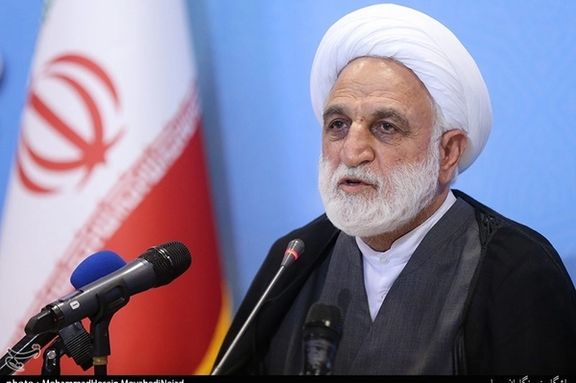
Iran’s judiciary chief is pushing to override parliamentary approval on the upcoming hijab bill.
Gholamhossein Mohseni Ejei says there is a law to deal with ‘social anomalies and its manifestations’, which means parliament can be circumvented.
Ejei made the remarks on Monday during a meeting with President Ebrahim Raisi who welcomed the suggestion.
Affirming the zeal to override the parliament's authority, Zabihollah Khodaian, head of Iran's General Inspection Organization, also claimed in the meeting, “that the existing law has specified that defying the hijab rule in public and on roads is a crime.” He also called on the judicial officials not to wait for an order in dealing with removal of hijab and "fulfill their duties".
In July 2022, after weeks of harsh measures on the streets, President Ebrahim Raisi ordered all government entities to strictly implement a “chastity and hijab” law approved by the Supreme Cultural Revolution Council under hardliner Mahmoud Ahmadinejad in 2005.
Not long after that, the death of the 22-year-old Mahsa Amini in the custody of hijab enforcers fueled protests that spread throughout the country.
Since March hardliners have tried to put an end to women’s increasing defiance of the compulsory hijab and to reclaim the lost ground but to no avail.
Earlier, Iran's media published the final version of a new hijab bill prepared jointly by the judiciary and the government. However, the draft was strongly criticized by hardliners which saw its punishments for unveiling “too lenient” to be able to stop women from unveiling.
The bill, however, also includes provisions against “anyone” other than authorized entities, who confronts citizens in public and uses violence and threats against unveiled women, after months of incitement by radical clerics calling on all citizens to take the law into their own hands as a moral duty.